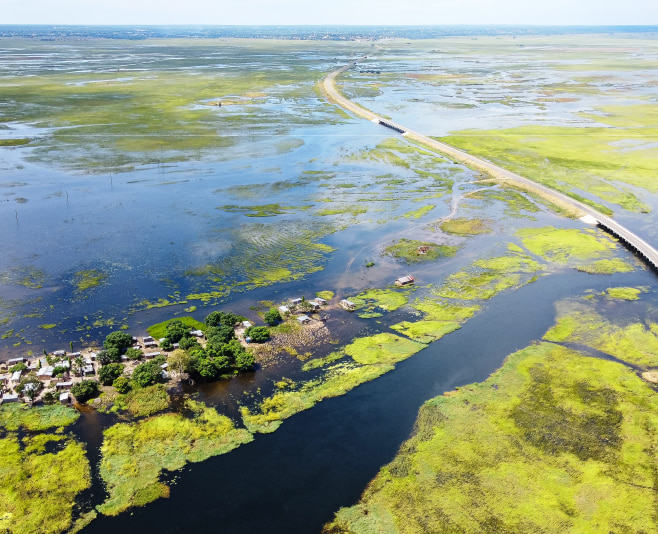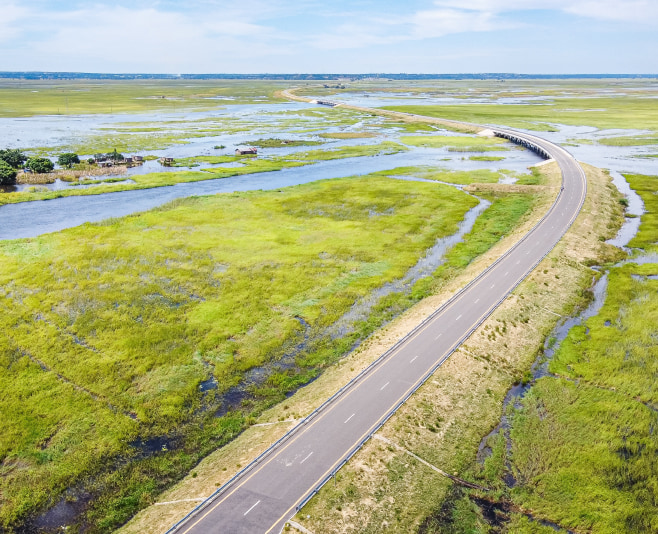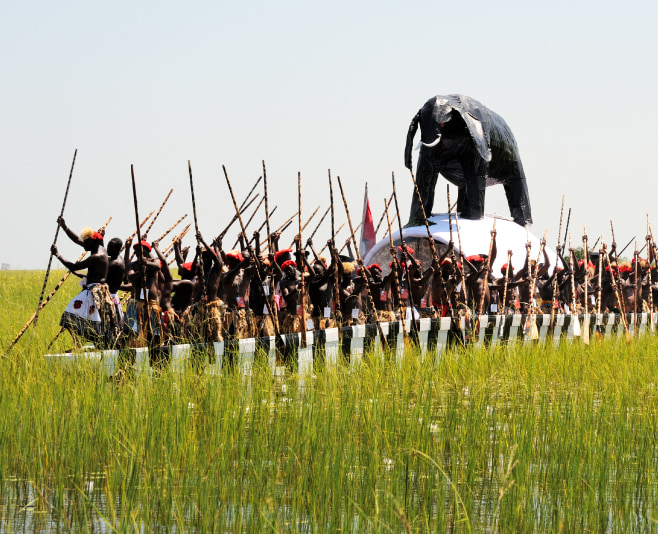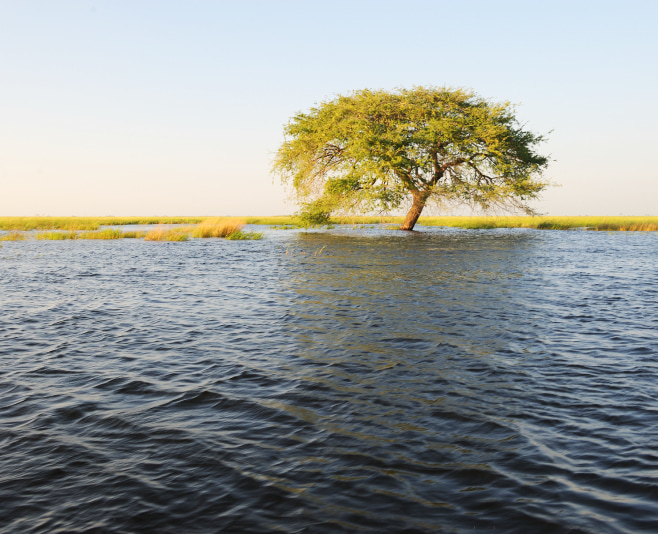Barotse Floodplain: Importance of Zambia’s seasonal wetland
One of the most ecologically, as well as culturally significant landscapes in Zambia, is Barotse Floodplain also referred to as Bulozi plain. It is in the Western Province and is not only a flood basin of the great Zambezi River but also the origin of the ancient Lozi Kingdom. The paper is a legal and environmental analysis of the floodplain that concentrates on the geography of the floodplain, its cultural background, its socioeconomic significance, its legal defence and its threats.

Aerial panoramic view of the Barotse Floodplain
Geographic overview
Location and boundaries
Barotse Floodplain is a 5,500 square kilometer area along the upper Zambezi River in Western Zambia. It runs south to Senanga and north to just north of Lukulu, and is flanked by the dry sandy Kalahari plains. The natural levees and grasslands bordering the floodplain make it an impressive topography of hydrology and seasonal change.
Hydrological features
Flood pulses annually as a result of the upstream rainfall in Angola, particularly the headwaters of the Zambezi characterizes the plain. The most severe floods typically occur during the months of March, April and May and these floods spread over the grasslands, fertilize the soils, add to the biodiversity in the water bodies and to the movement of people to graze and to cultivate crops.
Historical and cultural context
The Lozi Kingdom and Barotseland
Barotse Floodplain is a historical center of Barotseland, the historical land of the Lozi (Barotse) people. The region was once an independent state governed by Litunga, the King of Lozi and is a cultural leader as of today. The various cultural identities and the right to govern this region have long been acknowledged by the historical treaties like the Barotseland agreement of 1964.
Traditional land use and settlements
Floodplain communities have always learned to live with seasonal flooding. There is a tendency to move villages across highlands and lowlands with regard to water levels. This transhumance culture is extremely entrenched in the local legal practices that are overseen by the authority of the Litunga and the Barotse Royal Establishment.

Barotse Floodplain near the city Mongu in Western Province, Zambia
Ecological significance
Biodiversity hotspot
Barotse Floodplain is an Important Bird Area (IBA) and it has several species like the wattled cranes, saddle-billed stork and the endangered shoebill stork. It has large wetlands that harbor migratory and endemic species, thus an important biodiversity sanctuary.
Seasonal wetlands and aquatic life
The flood waters are nutrient enriched and offer abundant fish species such as tigerfish, tilapia and catfish and the area is regarded as the most productive inland fisheries in Zambia. Also, the rare wetland vegetation found in the floodplain is significant in the carbon sequestration and purification of water.
Socioeconomic importance
Agricultural practices
The floodplain has dynamic human geography, as the Kuomboka (or the seasonal migration of the Litunga to dry land in the flooded plains) ceremony depicts. After the flood waters recede, residents practice recession agriculture where they plant crops like maize, millet and cassava.
Fishing and livelihoods
Fishing is a major source of subsistence as well as commercial revenue. Fishing seasons are regulated by local laws in order to make them sustainable. Various communities depend on the traditional fishing methods, which are an element of indigenous knowledge systems inherited over generations.
Livestock grazing cycles
In the dry season enormous herds of cattle are driven into the floodplain to graze. Cattle are not merely an economic resource, but a cultural and legal resource as well among the Lozi, where they commonly feature in marriage contracts and compensation payments.

A beautiful Lemaire’s Toad (Sclerophrys lemairii) near the barotse floodplain, western Zambia
Seasonal flooding cycle
Role of the Zambezi River
The floodplain is a natural cushion during heavy rains which takes up surplus water in the Zambezi River. This will avoid flooding downstream in towns such as Mongu and will act as a climate resilience strategy in the area.
Human adaptation and mobility
The seasonal migration of people, animals and infrastructure (including floating houses and granaries) portrays a legal balance between the environmental limitations and human strength. The common system of governance involves the management of relocation and land distribution to establish equity and reduce conflict.
Legal and environmental protections
Conservation frameworks
The Barotse Floodplain is recognized under Zambia’s Environmental Management Act and other national frameworks. Although not formally designated a National Park, several proposals advocate for its recognition under Ramsar Convention criteria due to its wetland importance.
Indigenous rights and governance
The use of land in the floodplain is centered on customary law. The interaction between statutory law and customary governance, particularly in the sphere of resource access, conservation and dispute resolution, has been observed by legal scholars as being quite complicated. The Barotse Royal Establishment still exerts quasi-legal control of land tenure.
Climate change impacts
Increased flood variability
Climatic fluctuations have also brought unpredictable flood patterns, which endanger ecosystems and economic survival of people. Slowed or decreased flooding depletes fish populations, affects crop cycles and disrupts conventional land use patterns.
Threats to traditional lifestyles
Environmental degradation is being caused by global warming, clearing of forests upstream, and commercial developments. Such pressures threaten to displace the indigenous populations and destroy centuries of coexistence with the environment.

The traditional annual Kuomboka ceremony when the king of the Lozi tribe of Barotseland
Tourism and sustainable development
Ecotourism opportunities
The beautiful floodplain has unexplored ecotourism potential. Birdwatching, fishing trips and guided cultural tours are some of the activities that can be used to find a way to earn revenue and maintain the ecological integrity of the area.
Cultural tourism and community involvement
Traditions such as Kuomboka attract both local and foreign interest. Ethical and legal considerations in sustainable tourism should guarantee that the local communities own it, share the proceeds and their cultural heritage remains intact in its original state.
Challenges and developmental constraints
Infrastructure limitations
Inability to access floodplains seasonally restricts investment in infrastructure, such as roads, hospitals and schools. The legal systems need to strike a balance between development and environmental conservation particularly in wetland areas.
Balancing conservation with modernization
Zambia has a legal and policy dilemma, that is how to modernize the Barotse region without destroying its delicate ecosystem. Incorporating local consent processes and participatory governance and environmental impact assessments will be essential in the future.
FAQs
- What is the significance of the Kuomboka ceremony in the Barotse Floodplain?
The Kuomboka ceremony marks the Litunga's relocation from the flooded plains to higher grounds, symbolizing the seasonal adaptation of the Lozi people and their deep connection to the floodplain environment.
- Is the Barotse Floodplain legally protected as a conservation site?
While not yet a Ramsar site or National Park, it is covered under Zambia's environmental laws and enjoys a degree of protection through traditional governance and national policy proposals.
- How do communities adapt to seasonal flooding?
Residents engage in transhumance, shifting homes, livestock and agricultural activities seasonally. Floating structures and elevated homes are common adaptations.
- What are the main environmental threats facing the floodplain?
Climate change, upstream deforestation, unregulated fishing and infrastructural encroachment are leading threats to the floodplain’s ecological and social stability.
- Can tourists visit the Barotse Floodplain?
Yes, though access is limited during peak floods. Eco-friendly and culturally respectful tourism is encouraged, especially during events like Kuomboka or bird migration seasons.

Barotse flood plains in the Zambezi River over the brim
Conclusion
The Barotse Floodplain is not only a flood plain but a living tapestry of ecological resilience, indigenous legal traditions and socio-cultural values. It is a life giver to Zambia and the southern African region as its seasonal cycles support human and natural systems and can therefore not be substituted. With the mounting pressures of climate change and modernization, such a coordinated effort that is based on legal protection, community governance, and sustainable development will be necessary to protect this national asset.
Related Articles
- Air Charter Zambia: Tourist guide to flights, safaris & transfers
- Ngonye Falls: Zambia’s natural beauty and cultural heritage
- Luambe National Park: Discover Zambia’s untouched wilderness
- Lavushi Manda National Park: Zambia’s hidden gem
- Sioma Ngwezi National Park: Wildlife and travel guide in Zambia
- Zambia eVisa (online visa) or visa on arrival: Key differences
- Barotse Floodplain: Importance of Zambia’s seasonal wetland




